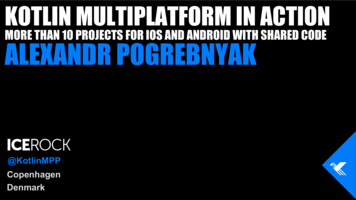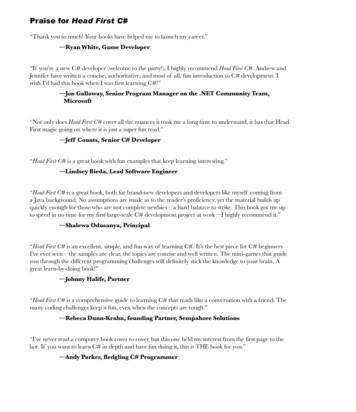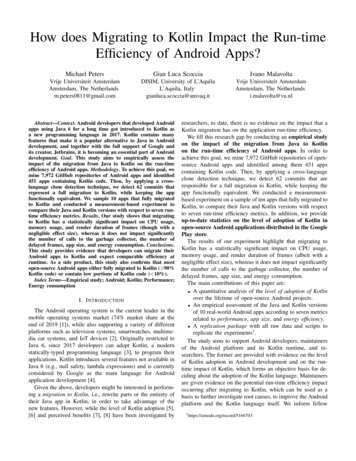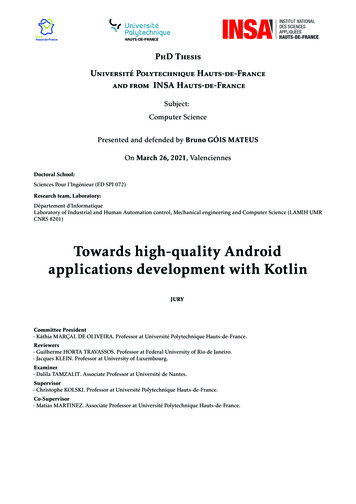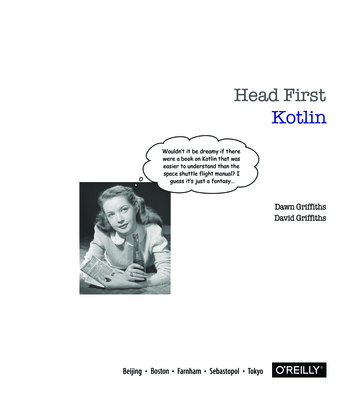
Transcription
Head FirstKotlinWouldn’t it be dreamy if therewere a book on Kotlin that waseasier to understand than thespace shuttle flight manual? Iguess it’s just a fantasy Dawn GriffithsDavid GriffithsBoston
Head First Kotlinby Dawn Griffiths and David GriffithsCopyright 2019 Dawn Griffiths and David Griffiths. All rights reserved.Printed in Canada.Published by O’Reilly Media, Inc., 1005 Gravenstein Highway North, Sebastopol, CA 95472.O’Reilly Media books may be purchased for educational, business, or sales promotional use. Online editions arealso available for most titles (http://oreilly.com). For more information, contact our corporate/institutional salesdepartment: (800) 998-9938 or corporate@oreilly.com.Series Creators:Kathy Sierra, Bert BatesEditor: Jeff BleielCover Designer:Randy ComerProduction Editor:Kristen BrownProduction Services:Jasmine KwitynIndexer: Lucie HaskinsBrain image on spine:Eric FreemanPage Viewers:Mum and Dad, Laura and AishaPrinting History:February 2019: First Edition.Mum and DadAisha and LauraThe O’Reilly logo is a registered trademark of O’Reilly Media, Inc. The Head First series designations,Head First Kotlin, and related trade dress are trademarks of O’Reilly Media, Inc.Many of the designations used by manufacturers and sellers to distinguish their products are claimed astrademarks. Where those designations appear in this book, and O’Reilly Media, Inc., was aware of a trademarkclaim, the designations have been printed in caps or initial caps.While every precaution has been taken in the preparation of this book, the publisher and the authors assume noresponsibility for errors or omissions, or for damages resulting from the use of the information contained herein.No Duck objects were harmed in the making of this book.ISBN: 978-1-491-99669-0[MBP]
To the brains behind Kotlin for creatingsuch a great programming language.
the authorsAuthors of He ad First KotlinsDavid GriffithDawn GriffithsDawn Griffiths has over 20 years experienceDavid Griffiths has worked as an Agile coach,working in the IT industry, working as a seniordeveloper and senior software architect. She haswritten various books in the Head First series, includingHead First Android Development. She also developed theanimated video course The Agile Sketchpad with herhusband, David, as a way of teaching key concepts andtechniques in a way that keeps your brain active andengaged.a developer and a garage attendant, but not in thatorder. He began programming at age 12 when hesaw a documentary on the work of Seymour Papert,and when he was 15, he wrote an implementation ofPapert’s computer language LOGO. Before writingHead First Kotlin, David wrote various other Head Firstbooks, including Head First Android Development, andcreated The Agile Sketchpad video course with Dawn.When Dawn’s not writing books or creating videos,you’ll find her honing her Tai Chi skills, reading,running, making bobbin lace, or cooking. Sheparticularly enjoys spending time with her wonderfulhusband, David.When David’s not writing, coding, or coaching, hespends much of his spare time traveling with his lovelywife—and coauthor—Dawn.ivYou can follow Dawn and David on Twitter at https://twitter.com/HeadFirstKotlin.
table of contentsTable of Contents (Summary)Introxxi1Getting Started: A quick dip12Basic Types and Variables: Being a variable313Functions Getting out of main594Classes and Objects: A bit of class915Subclasses and Superclasses: Using your inheritance1216Abstract Classes and Interfaces: Serious polymorphism1557Data Classes: Dealing with data1918Nulls and Exceptions: Safe and sound2199Collections: Get organized25110Generics: Know your ins from your outs28911Lambdas and Higher-Order Functions: Treating code like data32512Built-in Higher-Order Functions: Power up your code363iCoroutines: Running code in parallel397iiTesting: Hold your code to account409iiiLeftovers: The top ten things (we didn’t cover)415Table of Contents (the real thing)IntroYour brain on Kotlin. Here you are trying to learn something, while hereyour brain is, doing you a favor by making sure the learning doesn’t stick. Your brain’sthinking, “Better leave room for more important things, like which wild animals toavoid and whether naked snowboarding is a bad idea.” So how do you trick yourbrain into thinking that your life depends on knowing how to code in Kotlin?Who is this book for?xxiiWe know what you’re thinkingxxiiiWe know what your brain is thinkingxxiiiMetacognition: thinking about thinkingxxvHere’s what WE did:xxviRead me xxviiiThe technical review teamxxxAcknowledgments xxxiv
table of contentsgetting started1A Quick DipKotlin is making waves. From its first release, Kotlin has impressed programmers with its friendly syntax,conciseness, flexibility and power. In this book, we’ll teach you how to build yourown Kotlin applications, and we’ll start by getting you to build a basic application andrun it. Along the way, you’ll be introduced to some of Kotlin’s basic syntax, such asstatements, loops and conditional branching. Your journey has just begun.Being able to choosewhich platform to compileyour code against meansthat Kotlin code can runon servers, in the cloud,in browsers, on mobiledevices, and more.Welcome to Kotlinville 2You can use Kotlin nearly everywhere3What we’ll do in this chapter4Install IntelliJ IDEA (Community Edition)7Let’s build a basic application8You’ve just created your first Kotlin project11Add a new Kotlin file to the project12Anatomy of the main function13Add the main function to App.kt14Test drive 15What can you say in the main function?16Loop and loop and loop.17A loopy example 18Conditional branching 19Using if to return a value20Update the main function21Using the Kotlin interactive shell23You can add multi-line code snippets to the REPL24Mixed Messages 27Your Kotlin Toolbox 30JllieIntviAIDE
table of contents2basic types and variablesBeing a VariableThere’s one thing all code depends on—variables. So in this chapter, we’re going to look under the hood, and show you how Kotlinvariables really work. You’ll discover Kotlin’s basic types, such as Ints, Floats andBooleans, and learn how the Kotlin compiler can cleverly infer a variable’s type fromthe value it’s given. You’ll find out how to use String templates to construct complexStrings with very little code, and you’ll learn how to create arrays to hold multiplevalues. Finally, you’ll discover why objects are so important to life in Kotlinville.Your code needs variables32What happens when you declare a variable33The variable holds a reference to the object34Kotlin’s basic types 35IntLongEFByte ShortR5How to explicitly declare a variable’s type37Use the right value for the variable’s type38Assigning a value to another variable39We need to convert the value40What happens when you convert a value41Watch out for overspill42Store multiple values in an array45Create the Phrase-O-Matic application46Add the code to PhraseOMatic.kt47The compiler infers the array’s type from its values49var means the variable can point to a different array50val means the variable points to the same array forever.51Mixed References 54xYour Kotlin Toolbox 58Intvar Intvii
table of contents3functionsGetting Out of MainIt’s time to take it up a notch, and learn about functions. So far, all the code you’ve written has been inside your application’s main function. Butif you want to write code that’s better organized and easier to maintain, you need toknow how to split your code into separate functions. In this chapter, you’ll learn howto write functions and interact with your application by building a game. You’ll discoverhow to write compact single expression functions. Along the way you’ll find out howto iterate through ranges and collections using the powerful for loop.Let’s build a game: Rock, Paper, Scissors60A high-level design of the game61Get the game to choose an option63How you create functions64You can send more than one thing to a function 65You can get things back from a function66Functions with single-expression bodies67Add the getGameChoice function to Game.kt68The getUserChoice function75How for loops work76Ask the user for their choice78Mixed Messages 79We need to validate the user’s input81Add the getUserChoice function to Game.kt83Add the printResult function to Game.kt87Your Kotlin Toolbox89"Paper""Rock"StringEFStringval Array String 0viii"Scissors"REFRRoptionsEFREFString12
table of contents4classes and objectsA Bit of ClassIt’s time we looked beyond Kotlin’s basic types. Sooner or later, you’re going to want to use something more than Kotlin’s basictypes. And that’s where classes come in. Classes are templates that allow youto create your own types of objects, and define their properties and functions.Here, you’ll learn how to design and define classes, and how to use themto create new types of objects. You’ll meet constructors, initializer blocks,getters and setters, and you’ll discover how they can be used to protect yourproperties. Finally, you’ll learn how data hiding is built into all Kotlin code,saving you time, effort and a multitude of keystrokes.One classDognameweightbreedbark()92How to design your own classes93Let’s define a Dog class94How to create a Dog object95How to access properties and functions96Create a Songs application97The miracle of object creation98How objects are created99Behind the scenes: calling the Dog constructor100Going deeper into properties105Flexible property initialization106How to use initializer blocks107You MUST initialize your properties108How do you validate property values?111How to write a custom getter112How to write a custom setter113The full code for the Dogs project115Your Kotlin Toolbox120name: “Fido”weight: 70breed: “Mixed”REFMany objectsObject types are defined using classesmyDogDogvar DogDognameweightbreedbark()ix
table of contents5subclasses and superclassesUsing Your InheritanceEver found yourself thinking that an object’s type would beperfect if you could just change a few things? Well, that’s one of the advantages of inheritance. Here, you’ll learn how to createsubclasses, and inherit the properties and functions of a superclass. You’ll discoverhow to override functions and properties to make your classes behave the wayyou want, and you’ll find out when this is (and isn’t) appropriate. Finally, you’ll see howinheritance helps you avoid duplicate code, and how to improve your flexibility eroam()makeNoise()eat()WolfInheritance helps you avoid duplicate code122What we’re going to do123Design an animal class inheritance structure124Use inheritance to avoid duplicate code in subclasses125What should the subclasses override?126We can group some of the animals127Add Canine and Feline classes128Use IS-A to test your class hierarchy129The IS-A test works anywhere in the inheritance tree130We’ll create some Kotlin animals133Declare the superclass and its properties and functions as open134How a subclass inherits from a superclass135How (and when) to override properties136Overriding properties lets you do more than assign default values137How to override functions 138An overridden function or property stays open.139Add the Hippo class to the Animals project140Add the Canine and Wolf classes143imagefoodhabitatWhich function is called? 144makeNoise()eat()You can use a supertype for a function’s parameters and return type 147When you call a function on the variable, it’s the object’s versionthat responds 146The updated Animals code 148Your Kotlin Toolbox 153x
table of contents6abstract classes and interfacesSerious PolymorphismA superclass inheritance hierarchy is just the beginning. If you want to fully exploit polymorphism, you need to design using abstract classesand interfaces. In this chapter, you’ll discover how to use abstract classes to controlwhich classes in your hierarchy can and can’t be instantiated. You’ll see how they canforce concrete subclasses to provide their own implementations. You’ll find out howto use interfaces to share behavior between independent classes. And along theway, you’ll learn the ins and outs of is, as, and when.(interface)RoamableThe Animal class hierarchy revisited156Some classes shouldn’t be instantiated157Abstract or concrete? 158roam()Vehicleroam()An abstract class can have abstract properties and functions159The Animal class has two abstract functions160How to implement an abstract class162You MUST implement all abstract properties and functions163Let’s update the Animals project164Independent classes can have common behavior169An interface lets you define common behavior OUTSIDEa superclass hierarchy 170Treat me like theWolf you know I am.Let’s define the Roamable interface171How to define interface properties172Declare that a class implements an interface.173How to implement multiple interfaces174How do you know whether to make a class, a subclass,an abstract class, or an interface?175Update the Animals project 176EFInterfaces let you use polymorphismRitemval Roamable181Where to use the is operator 182WolfUse when to compare a variable against a bunch of options183The is operator usually performs a smart cast184Use as to perform an explicit cast185Update the Animals project 186Your Kotlin Toolbox 189xi
table of contents7data classesDealing with DataNobody wants to spend their life reinventing the wheel. Most applications include classes whose main purpose is to store data, so to makeyour coding life easier, the Kotlin developers came up with the concept of a data class.Here, you’ll learn how data classes enable you to write code that’s cleaner and moreconcise than you ever dreamed was possible. You’ll explore the data class utilityfunctions, and discover how to destructure a data object into its component parts.Along the way, you’ll find out how default parameter values can make your codemore flexible, and we’ll introduce you to Any, the mother of all superclasses. calls a function named e192equals is inherited from a superclass named Any193The common behavior defined by Any194We might want equals to check whether two objects are equivalent195A data class lets you create data objects196Data classes override their inherited behavior197Copy data objects using the copy function198Data classes define componentN functions.199Create the Recipes project 201Mixed Messages 203Data objectsare consideredequal if theirproperties holdthe same values.xiiGenerated functions only use properties defined in the constructor205Initializing many properties can lead to cumbersome code206How to use a constructor’s default values207Functions can use default values too210Overloading a function 211Let’s update the Recipes project212The code continued. 213Your Kotlin Toolbox 217
table of contents8nulls and exceptionsSafe and SoundEverybody wants to write code that’s safe. And the great news is that Kotlin was designed with code-safety at its heart. We’llstart by showing you how Kotlin’s use of nullable types means that you’ll hardly everexperience a NullPointerException during your entire stay in Kotlinville. You’ll discoverhow to make safe calls, and how Kotlin’s Elvis operator stops you being all shook up.And when we’re done with nulls, you’ll find out how to throw and catch exceptions likea pro.Thank youvery much.?:This is the Elvis operator.I'm gonna TRY thisrisky thing, and CATCHmyself if I fail.How do you remove object references from variables?220Remove an object reference using null221You can use a nullable type everywhere you can usea non-nullable type 222How to create an array of nullable types223How to access a nullable type’s functions and properties224Keep things safe with safe calls225You can chain safe calls together226The story continues. 227You can use safe calls to assign values.228Use let to run code if values are not null231Using let with array items232Instead of using an if expression.233The !! operator deliberately throws a NullPointerException234Create the Null Values project235The code continued. 236An exception is thrown in exceptional circumstances239Catch exceptions using a try/catch240Use finally for the things you want to do no matter what241An exception is an object of type Exception242You can explicitly throw exceptions244try and throw are both expressions245Your Kotlin Toolbox 250xiii
table of contents9collectionsGet OrganizedEver wanted something more flexible than an array? Kotlin comes with a bunch of useful collections that give you more flexibility andgreater control over how you store and manage groups of objects. Want to keepa resizeable list that you can keep adding to? Want to sort, shuffle or reverse itscontents? Want to find something by name? Or do you want something that willautomatically weed out duplicates without you lifting a finger? If you want any of thesethings, or more, keep reading. It’s all here.EFR0“Tea”StringR2REF253When in doubt, go to the Library254Fantastic Lists. 256“Coffee”String252List, Set and Map 255EF1Arrays can be useful.but there are things an array can’t handleCreate a MutableList. 257A List allowsduplicate values.List“ValueA”“ValueB”You can remove a value.258You can change the order and make bulk changes.259Create the Collections project260Lists allow duplicate values263How to create a Set264How a Set checks for duplicates265Hash codes and equality266Rules for overriding hashCode and equals267How to use a MutableSet268Update the Collections project270EFREFRREFTime for a Map 276How to use a Map277Create a MutableMap 278“KeyA”“KeyB”“KeyC”MapA Map allowsduplicate values, butnot duplicate keys.xivYou can remove entries from a MutableMap279You can copy Maps and MutableMaps280The full code for the Collections project281Mixed Messages 285Your Kotlin Toolbox 287
table of contents10genericsKnow Your Ins from Your OutsEverybody likes code that’s consistent. And one way of writing consistent code that’s less prone to problems is to usegenerics. In this chapter, we’ll look at how Kotlin’s collection classes use genericsto stop you from putting a Cabbage into a List Seagull . You’ll discover when and howto write your own generic classes, interfaces and functions, and how to restricta generic type to a specific supertype. Finally, you’ll find out how to use covarianceand contravariance, putting YOU in control of your generic type’s behavior.Collections use generics 290WITH generics, objectsgo IN as a reference toonly Duck objects.DuckDuckDuckDuckHow a MutableList is defined291Using type parameters with MutableList292Things you can do with a generic class or interface293Here’s what we’re going to do294Create the Pet class hierarchy295Define the Contest class 296Add the scores property 297MutableList Duck Create the getWinners function298Create some Contest objects 299Create the Generics project 301The Retailer hierarchy 305DuckDuckDuck.and come OUT as areference of type Duck.DuckDefine the Retailer interface 306We can create CatRetailer, DogRetailer and FishRetailer objects.307Use out to make a generic type covariant308Update the Generics project 309We need a Vet class 313Create Vet objects 314Vet T: Pet Use in to make a generic type contravariant315A generic type can be locally contravariant316Update the Generics project 317treat(t: T)Your Kotlin Toolbox 324xv
table of contents11lambdas and higher-order functionsTreating Code Like DataWant to write code that’s even more powerful and flexible? If so, then you need lambdas. A lambda—or lambda expression—is a block of codethat you can pass around just like an object. Here, you’ll discover how to definea lambda, assign it to a variable, and then execute its code. You’ll learn aboutfunction types, and how these can help you write higher-order functions that uselambdas for their parameter or return values. And along the way, you’ll find out how alittle syntactic sugar can make your coding life sweeter.Introducing lambdas 326λKgs to PoundsPounds to US TonsWe'll create afunction that combine()combines twolambdas into asingle lambda.λKgs to US TonsYou can assign a lambda to a variable328Lambda expressions have a type331The compiler can infer lambda parameter types332Use the right lambda for the variable’s type333Create the Lambdas project 334You can pass a lambda to a function339Invoke the lambda in the function body340What happens when you call the function341You can move the lambda OUTSIDE the ()’s.343Update the Lambdas project 344A function can return a lambda347Write a function that receives AND returns lambdas348How to use the combine function349Use typealias to provide a different name for an existing type353Update the Lambdas project 354Your Kotlin Toolbox 361λaddFive(Int) - IntRI take two Intparameters named x andy. I add them together,and return the result.327EFλWhat lambda code looks likeλLambdaxvi{ x: Int, y: Int - x y }val(Int) - Int{ it 5 }
table of contents12built-in higher-order functionsPower Up Your CodeKotlin has an entire host of built-in higher-order functions. And in this chapter, we’ll introduce you to some of the most useful ones. You’ll meetthe flexible filter family, and discover how they can help you trim your collection downto size. You’ll learn how to transform a collection using map, loop through itsitems with forEach, and how to group the items in your collection using groupBy.You’ll even use fold to perform complex calculations using just one line of code. Bythe end of the chapter, you’ll be able to write code more powerful than you everthought possible.These items have no naturalorder. To find the highestor lowest value, we need tospecify some criteria, suchas unitPrice or quantity.Kotlin has a bunch of built-in higher-order functions364The min and max functions work with basic types365A closer look at minBy and maxBy’s lambda parameter366The sumBy and sumByDouble functions367Create the Groceries project368Meet the filter function371Use map to apply a transform to your collection372What happens when the code runs373The story continues. 3742EFREF2R1IntEF0IntList Int 375forEach has no return value376Update the Groceries project377Use groupBy to split your collection into groups381You can use groupBy in function call chains382How to use the fold function383Behind the scenes: the fold function384Some more examples of fold386Update the Groceries project387Mixed Messages 3913RThe foldfunctionstartswith thefirst itemin thecollection.1forEach works like a for loopYour Kotlin Toolbox 394Leaving town. 395Intxvii
table of contentsicoroutinesRunning Code in ParallelSome tasks are best performed in the background. If you want to read data from a slow external server, you probably don’t want therest of your code to hang around, waiting for the job to complete. In situations suchas these, coroutines are your new BFF. Coroutines let you write code that’s runasynchronously. This means less time hanging around, a better user experience,and it can also make your application more scalable. Keep reading, and you’ll learn thesecret of how to talk to Bob, while simultaneously listening to Suzy.Bam! Bam! Bam! Bam! Bam! Bam!Tish!Tish!This time, the toms andcymbals play in parallel.iitestingHold Your Code to AccountEverybody knows that good code needs to work. But each code change that you make runs the risk of introducing fresh bugs that stopyour code from working as it should. That’s why thorough testing is so important: itmeans you get to know about any problems in your code before it’s deployed to the liveenvironment. In this appendix, we’ll discuss JUnit and KotlinTest, two libraries whichyou can use to unit test your code so that you always have a safety net.xviii
table of contentsiiileftoversThe Top Ten Things (We Didn’t Cover)Even after all that, there’s still a little more. There are just a few more things we think you need to know. We wouldn’t feel rightabout ignoring them, and we really wanted to give you a book you’d be able to liftwithout training at the local gym. Before you put down the book, read through thesetidbits.x: Stringy: StringOuterInnerThe Inner and Outer objects share aspecial bond. The Inner can use theOuter’s variables, and vice versa.1. Packages and imports4162. Visibility modifiers4183. Enum classes4204. Sealed classes4225. Nested and inner classes4246. Object declarations and expressions 4267. Extensions 4298. Return, break and continue4309. More fun with functions43210. Interoperability 434xix
Head First Kotlin, David wrote various other Head First books, including Head First Android Development, and created The Agile Sketchpad video course with Dawn. When David's not writing, coding, or coaching, he spends much of his spare time traveling with his lovely wife—and coauthor—Dawn. You can follow Dawn and David on Twitter at https://

